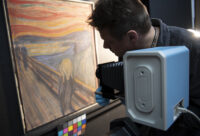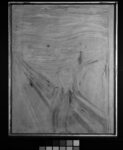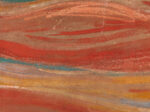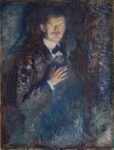 A graffito in the orange sky of Edvard Munch’s first version of The Scream declaring it “Can only have been painted by a madman” has been identified as an addition by the artist himself. Painted in 1893, The Scream was on display in Copenhagen in 1904 when the handwritten line was first noticed by a Danish art critic. He assumed one of the visitors to the exhibition had written his disapproval of the maker on the work. Later art historians posited that Munch was the author, but scholars as recently as 2008 have disputed that he was the writer of the inscription.
A graffito in the orange sky of Edvard Munch’s first version of The Scream declaring it “Can only have been painted by a madman” has been identified as an addition by the artist himself. Painted in 1893, The Scream was on display in Copenhagen in 1904 when the handwritten line was first noticed by a Danish art critic. He assumed one of the visitors to the exhibition had written his disapproval of the maker on the work. Later art historians posited that Munch was the author, but scholars as recently as 2008 have disputed that he was the writer of the inscription.
 Experts at the National Museum of Norway have taken advantage of the closure of the museum during renovations to conserve and study The Scream. Examination under a microscope confirmed that the pencil lines were written on top of the dried paint after the painting was finished, but the inscription is faint and hard to read. Photographed in infrared, however, the carbon from the pencil graphite stands out from the brightly painted background making detailed handwriting analysis possible. The analysis left no doubt that Munch authored the inscription.
Experts at the National Museum of Norway have taken advantage of the closure of the museum during renovations to conserve and study The Scream. Examination under a microscope confirmed that the pencil lines were written on top of the dried paint after the painting was finished, but the inscription is faint and hard to read. Photographed in infrared, however, the carbon from the pencil graphite stands out from the brightly painted background making detailed handwriting analysis possible. The analysis left no doubt that Munch authored the inscription.
 It was likely written around two years after he made the painting. Munch exhibited The Scream in Norway in October 1895. By then it had already been seen in several other countries, but this was the first exhibition of the work for the Norwegian public. It did not go well. One art critic wrote that The Scream showed that Munch was not “a serious man with a normal brain.”
It was likely written around two years after he made the painting. Munch exhibited The Scream in Norway in October 1895. By then it had already been seen in several other countries, but this was the first exhibition of the work for the Norwegian public. It did not go well. One art critic wrote that The Scream showed that Munch was not “a serious man with a normal brain.”
There was much buzz about the subject of the painting being Munch himself screaming in his madness. Speculation on his mental state was rife a discussion of the exhibition at the Students Association in Kristiania. One medical student, Johan Scharffenberg, armchair diagnosed Munch as insane based on his work. Munch followed all this chatter and it troubled him deeply.
“We know that he we was very upset when critics of his work questioned his sanity and called his paintings a disgrace,” National Museum curator Mai Britt Guleng told ARTnews. “Mental illness was a sore point for Munch because there was a history of mental illness in his close family.”
Both Munch’s father and sister suffered bouts of depression, and the latter was also diagnosed with schizophrenia. By his own admission, Munch had neither a happy childhood nor a smooth adult life. “Disease, insanity, and death were the angels that attended my cradle, and since then have followed me throughout my life,” he once wrote. Exacerbated by his alcoholism, Munch was finally hospitalized after a nervous breakdown in 1908.
He explicitly wrestled with depression, loss, and anxiety in his paintings, which often featured phantoms of lost love and family. According to a diary entry, Munch conceived of The Scream while walking out at sunset in Kristiania where, upon viewing the blood red clouds, he sensed an “infinite scream passing through nature.”
Guleng believes the inscription was added after the Kristiania discussion, so late 1895 or early 1896. His intent in writing it can’t be scried with infrared.  It could have been an ironic statement spurred by all the critics calling him crazy, or an impulsive reaction to his own concerns that they might be right.
It could have been an ironic statement spurred by all the critics calling him crazy, or an impulsive reaction to his own concerns that they might be right.
The Scream will be back on public display when the new National Museum opens in 2022, alongside Self-Portrait with Cigarette, the painting that Scharffenberg presented as proof that Munch was not of sound mind.